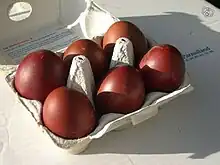Marans
The Marans, French: Poule de Marans, is a French breed of dual-purpose chicken, reared both for meat and for its dark brown eggs. It originated in or near the port town of Marans, in the département of Charente-Maritime, in the Nouvelle-Aquitaine region of south-western France.
 A cuckoo Marans hen | |
| Other names |
|
|---|---|
| Country of origin | France |
| Standard | Marans-Club de France (in French) |
| Traits | |
| Weight | |
| Egg colour | dark brown |
| Comb type | single |
| Classification | |
| APA | Continental[2] |
| EE | yes[3] |
| PCGB | soft feather: heavy[4] |
| |
The eggs are of a rich brown, varying from mahogany to chocolate; only one other chicken breed, the Penedesenca of Catalonia, has such a dark egg.[5]: 210
History
The Marans originated in – and is named for – the town of Marans, in the département of Charente-Maritime, in the Nouvelle-Aquitaine region of south-western France.[6]: 194 [7]: 172
It was created with the local feral chickens descended from fighting game chickens carried from Indonesia and India. Those original Marandaise fowl were "improved" for the table through recombination with imported Croad Langshans.
It was first shown in La Rochelle in 1914 under the name poule du pays or 'local chicken'. A breed society was formed in 1929, and in 1931 the first breed standard was drawn up.[8]: 56
Several clutches of fertile eggs were imported to the United Kingdom in or soon after 1929 by Charles Kelvynge Greenway, the second Baron Greenway, and some were hatched.[9]: 126 However, it is not certain that the Marans – with unfeathered shanks – shown by Lord Greenway at the Crystal Palace in 1934 descended even partly from this French stock.[9]: 126 According to the Poultry Club of Great Britain, the British Marans derives from cross-breeding of a variety of breeds including the Braekel, the Coucou de Malines, the Coucou de Rennes, the Croad Langshan, the Gâtinaise, the Faverolles and the barred Plymouth Rock.[6]: 194 [7]: 172 It may be a distinct breed, unconnected to the French Marans.[9]: 127
Characteristics
Ten colours are recognised in the French breed standard for large fowl: white, wheaten, silver cuckoo, golden cuckoo, black, copper-black, silver-black, copper-blue, black-tailed buff and Columbian.[1] Bantam colours are black, white, copper-black and silver cuckoo.[1] Fourteen colours are listed by the Entente Européenne.[3] The British type, with unfeathered legs, is not recognised in France.[1]
In the United Kingdom five colours are recognised: black, dark cuckoo, golden cuckoo and silver cuckoo, with unfeathered shanks; and copper-black, with feathered shanks.[6]: 195 [7]: 172
They should have orange eyes. The shanks are usually slate or pink, the soles of the feet should always be white as Marans have white skin, not yellow. Though the original Marans could also be feather-legged birds, British breeders preferred the clean-legged version, and thus feather-legged Marans are now mainly found in France and the United States. The Australian Poultry Standard recognises both feather- and clean-legged.[10] The American Poultry Association only recognises feather-legged.
Use

Marans hens lay around 150–200 dark brown eggs each year depending on the variety. Marans are historically a dual-purpose bird, prized not only for their dark eggs but for their table qualities as well.
References
- Standard officiel de la Marans (in French). Marans-Club de France. Archived 4 March 2016.
- APA Recognized Breeds and Varieties: As of January 1, 2012. American Poultry Association. Archived 4 November 2017.
- Liste des races et variétés homologuée dans les pays EE (28.04.2013). Entente Européenne d’Aviculture et de Cuniculture. Archived 16 June 2013.
- Breed Classification. Poultry Club of Great Britain. Archived 12 June 2018.
- Pascale Nuttall, Laurent Bessol, Caroline Lesage (2020). Le guide Larousse des poules et du poulailler (in French). [Paris]: Larousse. ISBN 9782035939647.
- J. Ian H. Allonby, Philippe B. Wilson (editors) (2018). British Poultry Standards: complete specifications and judging points of all standardized breeds and varieties of poultry as compiled by the specialist breed clubs and recognised by the Poultry Club of Great Britain, seventh edition. Chichester; Hoboken, New Jersey: Wiley Blackwell. ISBN 9781119509141.
- Victoria Roberts (2008). British Poultry Standards: complete specifications and judging points of all standardized breeds and varieties of poultry as compiled by the specialist breed clubs and recognised by the Poultry Club of Great Britain, sixth edition. Oxford: Blackwell. ISBN 9781405156424.
- Nathalie Semenuik, Georges Pernot (2008). Les poules (in French). [Paris]: Editions Artémis. ISBN 9782844166937.
- David Scrivener (2009). Popular Poultry Breeds. Ramsbury, Marlborough: The Crowood Press Ltd. ISBN 9781847979711.
- 2nd Australian Poultry Standard, 2012, published by the Victorian Poultry Breeder Association (trading as Poultry Stud Breeders and Exhibitors Victoria)